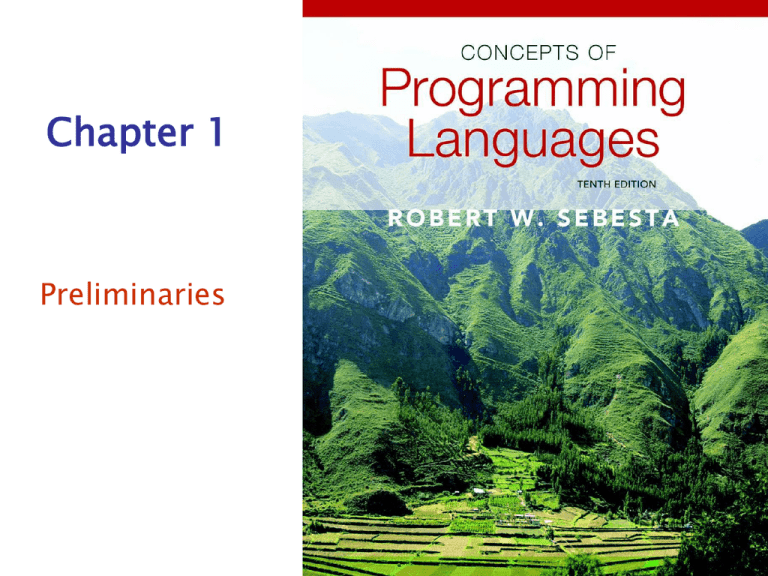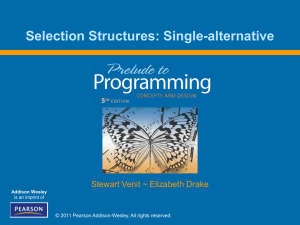
Chapter 1
Preliminaries
Chapter 1 Topics
• Reasons for Studying Concepts of
Programming Languages
• Programming Domains
• Language Evaluation Criteria
• Influences on Language Design
• Language Categories
• Language Design Trade-Offs
• Implementation Methods
• Programming Environments
Copyright © 2012 Addison-Wesley. All rights reserved.
1-2
Reasons for Studying Concepts of
Programming Languages
• Increased ability to express ideas
• Improved background for choosing
appropriate languages
• Increased ability to learn new languages
• Better understanding of significance of
implementation
• Better use of languages that are already
known
• Overall advancement of computing
Copyright © 2012 Addison-Wesley. All rights reserved.
1-3
Programming Domains
• Scientific applications
– Large numbers of floating point computations; use of arrays
– Fortran
• Business applications
– Produce reports, use decimal numbers and characters
– COBOL
• Artificial intelligence
– Symbols rather than numbers manipulated; use of linked lists
– LISP
• Systems programming
– Need efficiency because of continuous use
– C
• Web Software
– Eclectic collection of languages: markup (e.g., HTML),
scripting (e.g., PHP), general-purpose (e.g., Java)
Copyright © 2012 Addison-Wesley. All rights reserved.
1-4
Language Evaluation Criteria
• Readability: the ease with which
programs can be read and understood
• Writability: the ease with which a
language can be used to create programs
• Reliability: conformance to specifications
(i.e., performs to its specifications)
• Cost: the ultimate total cost
Copyright © 2012 Addison-Wesley. All rights reserved.
1-5
Evaluation Criteria: Readability
•
Overall simplicity
•
Orthogonality
–
–
–
A manageable set of features and constructs
Minimal feature multiplicity
Minimal operator overloading
–
–
A relatively small set of primitive constructs can be combined in a
relatively small number of ways
Every possible combination is legal
–
Adequate predefined data types
–
–
–
Identifier forms: flexible composition
Special words and methods of forming compound statements
Form and meaning: self-descriptive constructs, meaningful keywords
•
Data types
•
Syntax considerations
Copyright © 2012 Addison-Wesley. All rights reserved.
1-6
Evaluation Criteria: Writability
• Simplicity and orthogonality
– Few constructs, a small number of primitives, a small set of
rules for combining them
• Support for abstraction
– The ability to define and use complex structures or
operations in ways that allow details to be ignored
• Expressivity
– A set of relatively convenient ways of specifying operations
– Strength and number of operators and predefined functions
Copyright © 2012 Addison-Wesley. All rights reserved.
1-7
Evaluation Criteria: Reliability
• Type checking
– Testing for type errors
• Exception handling
– Intercept run-time errors and take corrective measures
• Aliasing
– Presence of two or more distinct referencing methods for the
same memory location
• Readability and writability
– A language that does not support “natural” ways of expressing
an algorithm will require the use of “unnatural” approaches, and
hence reduced reliability
Copyright © 2012 Addison-Wesley. All rights reserved.
1-8
Evaluation Criteria: Cost
• Training programmers to use the
language
• Writing programs (closeness to particular
applications)
• Compiling programs
• Executing programs
• Language implementation system:
availability of free compilers
• Reliability: poor reliability leads to high
costs
• Maintaining programs
Copyright © 2012 Addison-Wesley. All rights reserved.
1-9
Evaluation Criteria: Others
• Portability
– The ease with which programs can be moved
from one implementation to another
• Generality
– The applicability to a wide range of applications
• Well-definedness
– The completeness and precision of the
language’s official definition
Copyright © 2012 Addison-Wesley. All rights reserved.
1-10
Influences on Language Design
• Computer Architecture
– Languages are developed around the prevalent
computer architecture, known as the von
Neumann architecture
• Program Design Methodologies
– New software development methodologies (e.g.,
object-oriented software development) led to
new programming paradigms and by extension,
new programming languages
Copyright © 2012 Addison-Wesley. All rights reserved.
1-11
Computer Architecture Influence
• Well-known computer architecture: Von Neumann
• Imperative languages, most dominant, because of
von Neumann computers
–
–
–
–
Data and programs stored in memory
Memory is separate from CPU
Instructions and data are piped from memory to CPU
Basis for imperative languages
• Variables model memory cells
• Assignment statements model piping
• Iteration is efficient
Copyright © 2012 Addison-Wesley. All rights reserved.
1-12
The von Neumann Architecture
Copyright © 2012 Addison-Wesley. All rights reserved.
1-13
The von Neumann Architecture
• Fetch-execute-cycle (on a von Neumann
architecture computer)
initialize the program counter
repeat forever
fetch the instruction pointed by the counter
increment the counter
decode the instruction
execute the instruction
end repeat
Copyright © 2012 Addison-Wesley. All rights reserved.
1-14
Programming Methodologies Influences
• 1950s and early 1960s: Simple applications; worry
about machine efficiency
• Late 1960s: People efficiency became important;
readability, better control structures
– structured programming
– top-down design and step-wise refinement
• Late 1970s: Process-oriented to data-oriented
– data abstraction
• Middle 1980s: Object-oriented programming
– Data abstraction + inheritance + polymorphism
Copyright © 2012 Addison-Wesley. All rights reserved.
1-15
Language Categories
• Imperative
– Central features are variables, assignment statements, and
iteration
– Include languages that support object-oriented programming
– Include scripting languages
– Include the visual languages
– Examples: C, Java, Perl, JavaScript, Visual BASIC .NET, C++
• Functional
– Main means of making computations is by applying functions to
given parameters
– Examples: LISP, Scheme, ML, F#
• Logic
– Rule-based (rules are specified in no particular order)
– Example: Prolog
• Markup/programming hybrid
– Markup languages extended to support some programming
– Examples: JSTL, XSLT
Copyright © 2012 Addison-Wesley. All rights reserved.
1-16
Language Design Trade-Offs
• Reliability vs. cost of execution
– Example: Java demands all references to array elements
be checked for proper indexing, which leads to increased
execution costs
• Readability vs. writability
Example: APL provides many powerful operators (and a large
number of new symbols), allowing complex computations
to be written in a compact program but at the cost of
poor readability
• Writability (flexibility) vs. reliability
– Example: C++ pointers are powerful and very flexible but
are unreliable
Copyright © 2012 Addison-Wesley. All rights reserved.
1-17
Implementation Methods
• Compilation
– Programs are translated into machine language; includes
JIT systems
– Use: Large commercial applications
• Pure Interpretation
– Programs are interpreted by another program known as
an interpreter
– Use: Small programs or when efficiency is not an issue
• Hybrid Implementation Systems
– A compromise between compilers and pure interpreters
– Use: Small and medium systems when efficiency is not the
first concern
Copyright © 2012 Addison-Wesley. All rights reserved.
1-18
Layered View of Computer
The operating system
and language
implementation are
layered over
machine interface of a
computer
Copyright © 2012 Addison-Wesley. All rights reserved.
1-19
Compilation
• Translate high-level program (source language)
into machine code (machine language)
• Slow translation, fast execution
• Compilation process has several phases:
– lexical analysis: converts characters in the source program
into lexical units
– syntax analysis: transforms lexical units into parse trees
which represent the syntactic structure of program
– Semantics analysis: generate intermediate code
– code generation: machine code is generated
Copyright © 2012 Addison-Wesley. All rights reserved.
1-20
The Compilation Process
Copyright © 2012 Addison-Wesley. All rights reserved.
1-21
Additional Compilation Terminologies
• Load module (executable image): the user
and system code together
• Linking and loading: the process of
collecting system program units and linking
them to a user program
Copyright © 2012 Addison-Wesley. All rights reserved.
1-22
Von Neumann Bottleneck
• Connection speed between a computer’s
memory and its processor determines the
speed of a computer
• Program instructions often can be executed
much faster than the speed of the
connection; the connection speed thus
results in a bottleneck
• Known as the von Neumann bottleneck; it is
the primary limiting factor in the speed of
computers
Copyright © 2012 Addison-Wesley. All rights reserved.
1-23
Pure Interpretation
• No translation
• Easier implementation of programs (run-time
errors can easily and immediately be displayed)
• Slower execution (10 to 100 times slower than
compiled programs)
• Often requires more space
• Now rare for traditional high-level languages
• Significant comeback with some Web scripting
languages (e.g., JavaScript, PHP)
Copyright © 2012 Addison-Wesley. All rights reserved.
1-24
Pure Interpretation Process
Copyright © 2012 Addison-Wesley. All rights reserved.
1-25
Hybrid Implementation Systems
• A compromise between compilers and pure
interpreters
• A high-level language program is
translated to an intermediate language that
allows easy interpretation
• Faster than pure interpretation
• Examples
– Perl programs are partially compiled to detect errors
before interpretation
– Initial implementations of Java were hybrid; the
intermediate form, byte code, provides portability to any
machine that has a byte code interpreter and a run-time
system (together, these are called Java Virtual Machine)
Copyright © 2012 Addison-Wesley. All rights reserved.
1-26
Hybrid Implementation Process
Copyright © 2012 Addison-Wesley. All rights reserved.
1-27
Just-in-Time Implementation Systems
• Initially translate programs to an intermediate
language
• Then compile the intermediate language of the
subprograms into machine code when they are
called
• Machine code version is kept for subsequent calls
• JIT systems are widely used for Java programs
• .NET languages are implemented with a JIT system
• In essence, JIT systems are delayed compilers
Copyright © 2012 Addison-Wesley. All rights reserved.
1-28
Preprocessors
• Preprocessor macros (instructions) are
commonly used to specify that code from
another file is to be included
• A preprocessor processes a program
immediately before the program is
compiled to expand embedded
preprocessor macros
• A well-known example: C preprocessor
– expands #include, #define, and similar
macros
Copyright © 2012 Addison-Wesley. All rights reserved.
1-29
Programming Environments
• A collection of tools used in software development
• UNIX
– An older operating system and tool collection
– Nowadays often used through a GUI (e.g., CDE, KDE, or
GNOME) that runs on top of UNIX
• Microsoft Visual Studio.NET
– A large, complex visual environment
• Used to build Web applications and non-Web applications in
any .NET language
• NetBeans
– Related to Visual Studio .NET, except for applications in
Java
Copyright © 2012 Addison-Wesley. All rights reserved.
1-30
Summary
• The study of programming languages is valuable for
a number of reasons:
– Increase our capacity to use different constructs
– Enable us to choose languages more intelligently
– Makes learning new languages easier
• Most important criteria for evaluating programming
languages include:
– Readability, writability, reliability, cost
• Major influences on language design have been
machine architecture and software development
methodologies
• The major methods of implementing programming
languages are: compilation, pure interpretation, and
hybrid implementation
Copyright © 2012 Addison-Wesley. All rights reserved.
1-31





